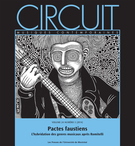Résumés
Abstract
In a short ‘vox pop,’ written for Circuit in 2010, on the subject of the ‘future’ of new music, I proposed that new music — or the version of it tightly intertwined with what was once thought of as the international avant-garde, at any rate — might today be better thought of as a sort of subculture, akin to the spectacular subcultures of goth and punk, but radically different in that they developed from the ‘grassroots,’ as it were, while new music comes from a position of extreme cultural privilege, which is to say it has access, even now, to modes of funding and infrastructure subcultures ‘proper’ never have. This essay develops this line of enquiry, outlining theories of subculture and post-subculture — drawing on ‘classic’ and more recent research, from Hebdige and Cohen to Hodkinson, Maffesoli, and Thornton — before presenting the, here more detailed, case that new music represents a sort of subculture, before making some tentative proposals regarding what sort of subculture it is and what this might mean for contemporary understandings of new music and what it is for.
Keywords:
- avant-garde,
- neo-tribes,
- new music,
- subculture
Résumé
Dans un court « vox pop » rédigé pour Circuit en 2010, sur le thème de « l’avenir » de la nouvelle musique, j’ai proposé que cette dernière – ou, dans tous les cas, sa version étroitement entremêlée avec ce qui fut considéré comme l’avant-garde internationale – puisse être aujourd’hui mieux pensée comme une sorte de sous-culture, semblable à celles, spectaculaires, du goth et du punk, quoique radicalement différente en ce que ces dernières se sont développées « de la base », pour ainsi dire, tandis que la nouvelle musique est issue d’une position extrêmement privilégiée culturellement : elle a accès, encore aujourd’hui, à des modes de financement et d’infrastructure dont les sous-cultures « à proprement parler » ne bénéficient jamais. Cet essai développe la question par la description des théories de la sous-culture et de la post-sous-culture – en faisant appel aux recherches tant « classiques » que plus récentes, de Hebdige et Cohen à Hodkinson, Maffesoli et Thornton –, avant de présenter le cas, plus détaillé ici, de cette nouvelle musique qui représente une sorte de sous-culture, puis d’énoncer quelques propositions provisoires sur la nature de cette sous-culture, ce que cela pourrait signifier pour la connaissance contemporaine de la nouvelle musique et à quoi cela pourrait servir.
Mots-clés :
- avant-garde,
- néo-tribus,
- nouvelle musique,
- sous-culture
Parties annexes
Bibliography
- Bennett, Andy (2000), Popular Music and Youth Culture: Music, Identity and Place, Basingstoke, Macmillan.
- Burgess, Jean E. (2004), “High Culture as Subculture: Brisbane’s Contemporary Chamber Music Scene,” MRes thesis, University of Queensland.
- Clarke, John et al. ([1975]2005), “Subcultures, Cultures and Class,” in Ken Gelder (ed.), The Subcultures Reader, 2nd edition, New York, NY, Routledge, p. 94-104.
- Cohen, Phil ([1972]2005), “Subcultural Conflict and Working-Class Community,” in Ken Gelder (ed.), The Subcultures Reader, 2nd edition, New York, NY, Routledge, p. 86-93.
- Cohen, Sara (1991), Rock Culture in Liverpool: Popular Music in the Making, Oxford, Oxford University Press.
- Finnegan, Ruth (1989), The Hidden Musicians: Music-Making in an English Town, Cambridge, Cambridge University Press.
- Gelder, Ken ([1997]2005), “The Field of Subcultural Studies,” in Ken Gelder (ed.), The Subcultures Reader, 2nd edition, New York, NY, Routledge, p. 1-15.
- Genet, Jean ([1949]2009), The Thief’s Journal, tr. Bernard Frechtman, London, Faber.
- Genet, Jean ([1964]2004), “Interview with Madeleine Gobeil,” in Jean Genet, The Declared Enemy: Texts and Interviews, ed. Albert Dichy, tr. Jeff Fort, Stanford, CA, Stanford University Press, p. 2-17.
- Gordon, Milton ([1947]2005), “The Concept of the Subculture and Its Application,” in Ken Gelder (ed.), The Subcultures Reader, 2nd edition, New York, NY, Routledge, p. 46-49.
- Halberstam, Judith and Livingston, Ira (1995), “Introduction,” in Judith Halberstam and Ira Livingston (eds.), Posthuman Bodies, Bloomington, IN, Indiana University Press, p. 1-20.
- Hebdige, Dick ([1979]2005), Subculture: The Meaning of Style, London, Routledge.
- Hodkinson, Paul (2002), Goth: Identity, Style and Subculture, Oxford, Berg.
- Hodkinson, Paul (2013), “Spectacular Youth Cultures and Ageing: Beyond Refusing to Grow Up,” Sociology Compass, vol. 7, no 1, p. 13-22.
- Iddon, Martin (2008), “The Dissolution of the Avant-Garde,” Search: Journal for New Music and Culture, no 1, no pagination.
- Iddon, Martin (2013), “Spectres of Darmstadt,” Tempo, vol. 67, no 263, p. 60-67.
- Irwin, John ([1970]2005), “The Status of the Concept Subculture,” in Ken Gelder (ed.), The Subcultures Reader, 2nd edition, New York, NY, Routledge, p. 73-77.
- Kruse, Holly (1993), “Subculture Identity in Alternative Music Culture,” Popular Music, vol. 12, no 1, p. 33-41.
- Lewin, Philip and Williams, J. Patrick (2009), “The Ideology and Practice of Authenticity in Punk Subculture,” in Phillip Vannini (ed.), Authenticity in Culture, Self, and Society, Farnham, Ashgate, p. 65-83.
- Maffesoli, Michel ([1988]1996), The Time of the Tribes: The Decline of Individualism in Mass Society, tr. Don Smith, London, Sage.
- Marchart, Oliver ([2003]2006), “Bridging the Micro-Macro Gap: Is There Such a Thing as a Post-subcultural Politics?,” in David Muggleton and Rupert Weinzierl (eds.), The Post-Subcultures Reader, Oxford, Berg, p. 83-97.
- Petridis, Alexis (2014), “Youth subcultures: what are they now?,” The Guardian (March 20), www.theguardian.com/culture/2014/mar/20/youth-subcultures-where-have-they-gone (accessed March 27, 2014)
- Shank, Barry (1994), Dissonant Identities: The Rock’n’Roll Scene in Austin, Texas, Hanover, NH, Wesleyan University Press.
- Stahl, Geoff ([2003]2006), “Tastefully Renovating Subcultural Theory: Making Space for a New Model,” in David Muggleton and Rupert Weinzierl (eds.), The Post-Subcultures Reader, Oxford, Berg, p. 27-40.
- Thornton, Sarah ([1995]2005), “The Social Logic of Subcultural Capital,” in Ken Gelder (ed.), The Subcultures Reader, 2nd edition, New York, NY, Routledge, p. 184-192.
- Ueno, Toshiya ([2003]2006), “Unlearning to Raver: Techno-Party as the Contact Zone in Trans-Local Formations,” in David Muggleton and Rupert Weinzierl (eds.), The Post-Subcultures Reader, Oxford, Berg, p. 101-117.
- Williams, Alex (2014), “The New Normal. Normcore: Fashion Movement or Massive In-Joke?,” The New Yorker (April 2), www.nytimes.com/2014/04/03/fashion/normcore-fashion-%ADmovement-or-massive-in-joke.html (accessed July 28, 2014).

